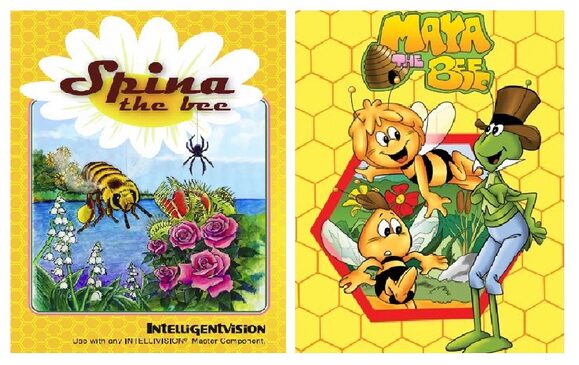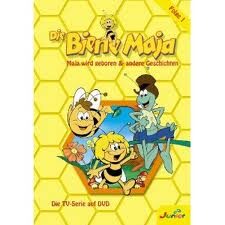
The inspiration for Intellivision's Spina The Bee has possibly finally been solved close to 30 years later. The official Intellivision Lives website only gives this description and not much information has ever been revealed.
INTELLIVISION CARTRIDGE [UNFINISHED]
AKA: Zzzz!
Developed at Nice Ideas (Mattel Electronics, France)
Design/program: Simonot
Graphics: Bob del Principe
Music/sound effects: Sam Zalan
PROGRAMMER'S DESCRIPTION
Gain as much pollen and bonus points as possible without raindrops pushing your bee into the water and without getting blown off the right side of the screen.
DEVELOPMENT HISTORY
Another of the first games developed at the French office, Spina the Bee was based on a European cartoon character, popular with little girls. (Since the rights to Spina had not been obtained, the title Zzzz! was used on the prototypes.)
The French office had been set up to develop games with a European sensibility, but after the Mattel Electronics management change of July 1983 and subsequent programmer layoffs in August, Mattel started to consider the French office simply as a source of programmers to handle the overflow from the California headquarters. The games from France would have to have wide appeal in the United States, as well.
Spina the Bee was judged not to have that wide appeal and was killed.
~
From The official Description it says based on a "European Cartoon Character". A quick internet search for that description and adding 'bee' quickly takes you to 'Maya the Bee' also translated to 'Biene Maja' in some languages. There is not really any other bee characters in Europe.

Maya The Bee also translated to Biene Maja
A quick search for 'Biene Maja' brings up alot of cartoons,video games on Gameboy and Gameboy Advance and Nintendo DS, and other related items just as Maya the Bee does. But one search lead to a Biene Maja video game for Atari from 1986. Just 2 years after Spina the Bee was cancelled. The game play for Biene Maja is VERY VERY similar to Mattel's Spina the Bee, too close to be ignored, The Bee is going to the right instead of to the left as in the Mattel version.
Many companies contributed worldwide to the success of the character by producing and selling merchandising. Most of them were drawn between 1976 and 1986 by the French licensed characters specialist André Roche.His works have included motifs for textiles, porcelain, books, comics and games, including a campaign for Kinder Surprise Eggs.
Biene Maja for Atari 8 Bit
Spina the Bee for Intellivision
So, is Mattel's Spina the Bee actually based on Maya the Bee? You decide.
Check out the opening for the Maya the Bee cartoon!
Maya the Bee for GameBoy Advance!
Maya the Bee has had several games available, mostly on handhelds.
- Spina the Bee (Intellivision - 1984 - Unreleased & Unconfirmed ROM)
- Biene Maja (Atari 8 bit PC - 1986 - Unreleased ROM)
- Maya The Bee & Her Friends (Game Boy Color - 1999)
- Maya the Bee and Friends (mobile – 2006)
- Maya the Bee: The Great Adventure (Game Boy Advance – 2002)
- Maya the Bee: Sweet Gold (Game Boy Advance – 2005)
- the Bee Game (Game Boy Advance,Nintendo DS– 2007)
- Spina the Bee (Intellivision, 2011 - by Intelligentvision) (unconfirmed)
The story of Maya the Bee began in a book written in 1912.
The Adventures of Maya the Bee (German: Die Biene Maja) is a German book, comic book series and animated television series, first written by Waldemar Bonsels and published in 1912. The book has been published also in many other languages.
The stories revolve around a little bee named Maya and her friends Willy the bee, Flip the grasshopper (referred to as "Maja", "Willi" and "Philip" in some versions), Mrs. Cassandra (Maya's teacher), and many other insects and other creatures. The book depicts Maya's development from an adventurous youngster to a responsible adult member of bee society.
Bonsels' original book contains fewer than 200 pages. The storyline is centered on the relation of Maya and her many adventures.
Maya is a bee born in a bee hive during internal unrest: the hive is dividing itself into two new colonies. Maya is raised by her teacher, Mrs. Cassandra. Despite Mrs. Cassandra's warnings, Maya wants to explore the wide world and commits the unforgivable crime of leaving the hive. During her adventures, Maya, now in exile, befriends other insects and braves dangers with them. In the climax of the book, Maya is taken prisoner by hornets, the bees' sworn enemies.

Prisoner of the hornets, Maya learns of a hornet plan to attack her native hive. Maya is faced with the decision to either return to hive and suffer her due punishment, saving the hive, or leaving the plan unannounced, saving herself but destroying the hive. As may be expected, Maya, after severe pondering, makes the decision to return. In the hive, she announces the coming attack and is, totally unexpectedly, pardoned. The forewarned bees triumph over the hornet attack force. Maya, now a heroine of the hive, becomes a teacher, like Mrs. Cassandra and shares her experiences and wisdom with the future generation.
Analysis of the book
The original book from 1912 was a fable with a political message, analogously to Jean de La Fontaine's or Ivan Krylov's work. Maya represents the ideal citizen, and the beehive represents a well-organized militarist society. It has also elements of nationalism and racism. Maya gets angry in two instances. First, a grasshopper fails to distinguish between bees and wasps. Maya's vicious verbal attack includes calling the wasps "a useless gang of bandits" [Räubergeschlecht] that have no "home or faith" [Heimat und Glauben]. Second, a fly calls Maya an idiot, which prompts Maya to shout that she's going to teach "respect for bees" and to threaten the fly with her stinger. This is analyzed such that respect is based on the threat of violence. Collectivism versus individualism is also a theme. Maya's independence and departure from the beehive is seen as reproachable, but it is atoned by her warning of the hornets' attack. This show of loyalty restores her position in the society. In the hornet attack part of the story, the bees' will to defend and the heroic deaths of bee officers are glorified, often in overtly militarist tones.
In the post-WWII adaptions, the militarist element was naturally toned down considerably, the hornets' role reduced, and the character of Willy, a lazy and quite un-warlike drone bee, was introduced (he does not appear in the novel). In the cartoon series, the briskly marching, but ridiculously incompetent ant armies provide a parody of militarism.
